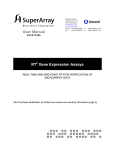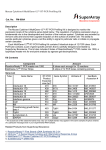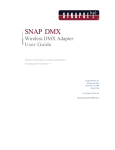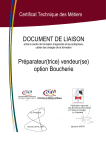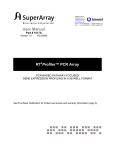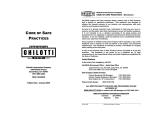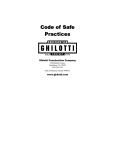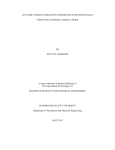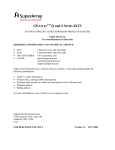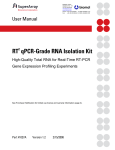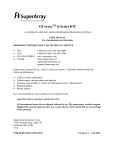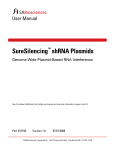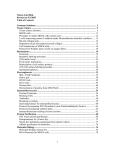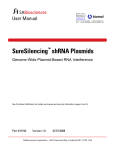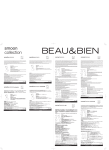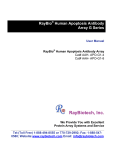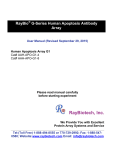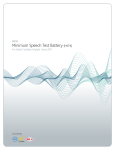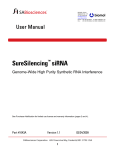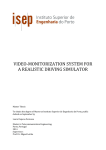Download SureSilencing Gene Specific siRNA Population
Transcript
SureSilencing™ siRNA Kit GENE-SPECIFIC siRNA POPULATIONS FOR EXPRESSION SUPPRESSION User Manual SuperArray Bioscience Co. 7320 Executive Way, Suite 101 Frederick, MD 21704 Telephone: 301-682-9200/1-888-503-3187 Fax: 301-682-7300/1-888-465-9859 Web site: www.superarray.com FOR RESEARCH USE ONLY Version 1.1 8/15/2003 SuperArray SureSilencing™ siRNA Kit User Manual (Version 1.1 8/15/2003) SureSilencing™ siRNA Kit GENE-SPECIFIC siRNA POPULATIONS FOR EXPRESSION SUPPRESSION USER MANUAL ORDERING INFORMATION AND TECHNICAL SERVICE • • • • TEL: FAX: ON-LINE ORDER: E-MAIL: 1-888-503-3187, 301-682-9200 1-888-465-9859, 301-682-7300 www.superarray.com [email protected] [email protected] [email protected] Orders may be placed by fax, e-mail or from our website. Each order should include the following information: • • • • • Caller’s contact information Product name, catalog number and quantity Purchase order number or credit card information (Visa or MasterCard) Shipping address Billing address For more information, visit us at http://www.superarray.com SuperArray Bioscience Corp. 7320 Executive Way, Suite 101 Frederick, MD 21704 USA 2 SuperArray SureSilencing™ siRNA Kit User Manual (Version 1.1 8/15/2003) 3 TABLE OF CONTENTS I. Background and Introduction 4 II. Kit Contents / Materials Provided 6 III. Additional Materials Required 6 IV. Protocols A. Transfection B. RT-PCR Verification C. Assay Effects of Silencing Gene Expression Appendix A: Use of Separate Components for RT-PCR Verification 7 8 11 12 V. Troubleshooting Guide 14 VI. References 16 LIMITED PRODUCT WARRANTY This product is intended for research purposes only and is not intended for drug or diagnostic purposes or for human use. This warranty limits our liability to replace this product in the event the product fails to perform due to any manufacturing defect. SuperArray Bioscience Corporation makes no other warranties of any kind, expressed or implied, including without limitation, warranties of merchantability or fitness for a particular purpose. SuperArray Bioscience Corporation shall not be liable for any direct, indirect, consequential or incidental damages arising out of the use, the results of use or the inability to use this product. NOTICE TO PURCHASER The purchase of SureSilencer siRNA Kit products includes a limited, nonexclusive license to use the kit components for research use only. This license does not grant rights to use the kit components for reproduction of any siRNA pool or primer mix, to modify kit components for resale or to use SureSilencer siRNA Kit to manufacture commercial products without written approval of SuperArray Bioscience Corporation. No other license, expressed, implied or by estoppel, is granted. U.S. patents may cover certain isolated DNA sequences included in the SureSilencer siRNA Kit. Presently, it is not clear under U.S. laws whether commercial users must obtain licenses from the owners of the rights to these U.S. patents before using SureSilencer siRNA Kits. SuperArray SureSilencing™ siRNA Kit User Manual (Version 1.1 8/15/2003) 4 I. BACKGROUND AND INTRODUCTION Small-interfering RNA (siRNA) refers to a class of 20 to 25 nucleotide doublestranded RNA (dsRNA) molecules with 2 nucleotide-long 3´-overhangs. Recently, Tuschl and colleagues (1,2) showed that siRNA could be used to silence specific genes in mammalian cells. Since then, these molecules have been used extensively for this purpose. However, their silencing ability varies. While some siRNA can silence gene expression by as much as 80-90%, others have no effect. Therefore, it is essential to test a number of siRNA duplexes to a given mRNA target before finding a functional one. Kits have been available for the production of siRNA pools and screening of individual siRNA duplexes; however, the fragment chosen for use must still be tested and may not work effectively. The process can become labor-intensive and expensive. SureSilencing™ siRNA pools for gene-specific suppression overcome this limitation. We take advantage of our already available gene-specific cDNA fragments used for our GEArray gene expression profiling systems. By incorporating two T7 promoters at both ends of a PCR product (500-800 bp), long dsRNA can then be prepared by in vitro transcription and digested with RNase III to produce a population of siRNA duplexes (3,4,5). Since many different siRNAs are included in the population, an appropriate siRNA should be present and gene expression can be efficiently supressed. As part of the quality control process, the SureSilencing™ siRNA population is quantitated using a spectrophotometer to standardize stock solution concentration and is visualized on a 15% non-denaturing acrylamide gel to verify that the toxic long dsRNA was completely digested. Every kit contains a population of RNase III-digested siRNA for a specific gene that has been tested and verified to suppress that gene’s expression by at least 70% in mammalian cells. A pair of gene-specific primers to verify the suppression of gene expression using RT-PCR is also enclosed. A negative control siRNA pool is also included. Features of the SureSilencing™ siRNA Kit: Knock down the expression of a specific gene Pre-tested and verified to suppress expression by at least 70 percent Ready to use, no enzymatic steps required Includes negative control siRNA Includes primers to verify down-regulation by RT-PCR SuperArray SureSilencing™ siRNA Kit User Manual (Version 1.1 8/15/2003) Overview of SureSilencing™ siRNA Kit Procedure Negative Control siRNA SureSilencing™ siRNA LipofectAMINE2000™ (Invitrogen) transient transfection CELLS CELLS 24 to 48 h incubation Harvest cells for RNA. Perform RT-PCR Verification. Verify decrease in message level of specific gene relative to negative control sample. AND / OR Perform other biochemical, molecular or cell biological assay. 5 SuperArray SureSilencing™ siRNA Kit User Manual (Version 1.1 8/15/2003) 6 II. KIT CONTENTS / MATERIALS PROVIDED BUFFER SI* PP* NC CONTENTS SureSilencing™ siRNA Population (YELLOW-topped tube) Gene-Specific Primer Pair (PINK-topped tube) Negative Control siRNA Population (CLEAR-topped tube) VOLUME 90 µl 50 µl 15 µl * The catalog number of the specific SureSilencing™ siRNA Kit appears on the tubes of Buffers SI and PP. These buffers are specific for each kit. Please do not combine with other SureSilencing™ siRNA Kits. The kit contains enough gene-specific siRNA population for 18 transfections using 6well plates or 35mm dishes (OR 90 transfections using a 24-well format). All components included in this kit should be stored at –20 °C and are guaranteed for 6 months from the date received. III. ADDITIONAL MATERIALS REQUIRED: A. For Transfection: 1. Transfection reagent: We highly recommend Lipofectamine2000™ (Invitrogen Cat #11668-027/-019). Others reagents may also be used; however, see Notes in the Protocols section. 2. Other materials required recommended by transfection reagent manufacturer. Opti-MEM (Gibco) B. For RT-PCR Verification of Gene Expression Knock-Down: OPTION 1: SuperArray Kits: a. ReactionReady™ First Strand cDNA Synthesis Kit b. ReactionReady™ PCR master mix 1000 C-01 P-1000A OPTION 2: Individual Components from other manufacturers listed below: Reagent Random Primers RNase Inhibitor Reverse Transcriptase Taq DNA Polymerase dNTPs C. 100-bp DNA Step Ladder Product Promega Catalog # C1181 Promega Catalog # N2511 Promega Catalog # M1701 Promega Catalog # M2661 Promega Catalog # U1330 Promega Catalog # G595A SuperArray SureSilencing™ siRNA Kit User Manual (Version 1.1 8/15/2003) 7 IV. PROTOCOLS A. Transfection The following is a sample protocol for HEK 293 cells using Lipofectamine2000™ (Invitrogen Catalog #11668-027/-019) in a 6-well format. (Numbers of cells and volumes for using a 24-well format are given in parentheses.) 1. One day before transfection, seed 2.5 x 105 (5.0 x 104) cells in each well of 6well plate (24-well plate) or in each 35-mm plate with 2 ml (400 µl) of growth medium. On the day of transfection: 2. Dilute 5 µl (1 µl) of Buffer SI and Buffer NC into separate 250 µl (50 µl) volumes of Opti-MEM™ I Reduced-Serum Medium (Gibco) and mix gently. Make one dilution for each well or plate. 3. For each well or plate, dilute 5 µl (1 µl) of Lipofectamine2000™ in 250 µl (50 µl) of Opti-MEM™. Mix gently and incubate both dilutions for 5 min at room temperature. 4. Combine each diluted siRNA Population with each 250 µl (50 µl) Lipofectamine2000™ dilution. Mix gently and incubate for 20 min at room temperature. 5. Add each 500 µl (100 µl) mixture of siRNA and Lipofectamine2000™ to its well containing cells and 2 ml (400 µl) of normal growth medium. Mix gently. 6. Incubate the cells at 37°C in a CO2 incubator for 24-48 hours. Harvest at least one well per siRNA population for RT-PCR verification. Use other wells to assay for effects of silencing gene expression. Note: Other transfection reagents optimized for siRNA may also be used (such as Oligofectamine™). However, SuperArray has tested several reagents, and Lipofectamine2000™ works optimally with our siRNA populations. If you choose to use other transfection reagents, follow the protocol as outlined by the reagent manufacturer. Assume a stock nucleic acid concentration of 0.4 mg/ml in Buffer SI when using other procedures. Please optimize these new conditions yourself. Note: SuperArray Biosciences uses HEK 293 cells for quality control purposes. A number of other cell lines (including HeLa, MCF7, and MDA-231) have been tested with success using a limited number of siRNA products and the above protocol. Plating, transfection, incubation and other conditions may vary with cell type. Please optimize these new conditions yourself. SuperArray SureSilencing™ siRNA Kit User Manual (Version 1.1 8/15/2003) 8 B. RT-PCR Protocol for Verifying Decrease in Gene Expression Complete kits for RT-PCR verification may be purchased from SuperArray Biosciences: ReactionReady™ First Strand cDNA Synthesis Kit (C-01) and ReactionReady™ PCR master mix 1000 (P-1000A). If using these products, follow the protocol described below. Individual components for RT-PCR may also be purchased separately from other manufacturers. (See the Additional Materials Required section.) For your convenience, an alternative protocol for RT-PCR is provided in Appendix A for using these individual reagents to verify the down-regulation of gene expression. 1. Cell Lysis / RNA Isolation Total RNA prepared using commercially available kits is suitable for RT-PCR analysis to verify silencing of gene expression. Total RNA prepared by Trizol Reagent (Invitrogen/Life Technologies, Cat. No. 15596-018), RNeasy mini kits (Qiagen, Cat. No. 74104) or RNAqueous (Ambion, Cat. No. 1911, 1912, or 1913) gives good results. We use the Qiagen RNeasy mini Kits for our quality control protocol. Total RNA should be dissolved in RNase-Free H2O at a concentration of 1.0 mg/ml. 2. RT Reaction: Using SuperArray ReactionReady™ First Strand cDNA Synthesis Kit: a. Prepare the Annealing Mixture: For each total RNA sample, combine the following into a sterile PCR tube: Total RNA Buffer P (Random Primers) RNase-free H2O to a final volume of 0.5 to 2.5 1.0 10.0 µg µl µl Mix the contents gently with a pipettor followed by brief centrifugation. Place the mixture in a thermal cycler at 70 °C for 3 min. Cool to 37 °C and keep at that temperature for 10 min. b. Prepare the RT Cocktail: This mixture can be prepared while the Annealing Mixture is incubating at 37 °C. Buffer BC (5X RT Buffer) RNase-free H2O RI (RNase Inhibitor) RE (Reverse Transcriptase) Final Volume 4 µl 4 µl 1 µl 1 µl 10 µl Warm the RT Cocktail at 37 °C for 1 min before proceeding to the next step. SuperArray SureSilencing™ siRNA Kit User Manual (Version 1.1 8/15/2003) 9 c. RT Reaction: Add the 10 µl RT Cocktail to the 10 µl Annealing Mixture. Mix well but gently with a pipettor and continue incubation at 37 °C for 60 min. Heat at 95 °C for 5 min to hydrolyze the RNA and to inactivate the reverse transcriptase. Hold the finished RT Reaction on ice until the next step. 3. PCR: Perform one reaction for each RNA sample. Add 150 µl of ddH2O to one tube of ReactionReady™ PCR master mix 1000 (P-1000A). Dissolve the lyophilized components by vortexing well. For each PCR, mix the following components together in a PCR tube: ReactionReady™ PCR master mix 1000 ddH2O RT Reaction Buffer PP Final volume 12.5 µl 10.5 µl 1.0 µl 1.0 µl 25.0 µl Program the thermal cycler for PCR as follows: 94 °C, 3 min; 25* cycles of (94 °C, 15 sec, 50 °C, 15 sec, 72 °C, 30 sec) * Note: DO NOT exceed the recommended number of cycles. 4. Product Characterization a. When the PCR is complete, load 10 µl of each reaction into separate wells of a 1% agarose gel containing 0.5 µg/ml ethidium bromide in 1X TAE. NOTE: No gel loading dye or buffer is required. The ReactionReady™ master mix 1000 already contains gel-loading dye. b. Load an appropriate amount of 100-bp DNA Step Ladder (Promega Catalog # G695A) in an adjacent lane. c. Electrophorese in 1X TAE at 80V for 40 min. Note: The gel dye runs at a size of 50 bp under these conditions. d. Capture image of gel on a UV Trans Illuminator using a CCD camera (or on high-speed film). e. The expected sizes of the PCR products are listed on the individual product information sheets. SuperArray SureSilencing™ siRNA Kit User Manual (Version 1.1 8/15/2003) 10 5. Image Acquisition and Data Acquisition and Analysis: a. Image Acquisition At this time, we highly recommend using a CCD camera to capture the image of the gel because the Data Acquisition will be more straightforward and the resulting data will have a wider dynamic range. A high-speed photograph can be used; however, the image must be digitized by other means, separate software must be used, and the dynamic range will be smaller. b. Data Acquisition If a CCD camera was used to capture the image of the gel, the software accompanying the instrument should be able to convert the image of the bands into data. Follow the instructions for that software. If relying on a high-speed photograph of the gel, digitize the image of the gel using a desktop scanner to obtain a TIFF file of the image. To convert that image into data, we then recommend using the software “NIH IMAGE” (Available free from the NIH. See the following web page and its links for more information: http://rsb.info.nih.gov/nih-image/). Follow the instructions for that software. c. Data Analysis During Data Acquisition, remember to use the software to determine an appropriate background value. That is, use the same rectangle or other shape used to surround the gel bands to surround a blank area of the gel and obtain data from that area. Subtract that background value from the integrated intensity values of all other data points obtained from the gel bands. The intensity of the RT-PCR product generated from cells treated with the gene-specific siRNA should be less than 30 percent that of the product from control siRNA-treated cells. SuperArray SureSilencing™ siRNA Kit User Manual (Version 1.1 8/15/2003) 11 C. Assay Effects of Silencing of Gene Expression There are many ways to characterize the effects on cells brought on by a decrease in the expression of a gene meditated by siRNA. The following is a brief list of possibilities. Your experiments need not be limited to these suggestions, however. SuperArray Bioscience has tested some of these applications using a limited number of products. Cells may be harvested, and RNA isolated for gene expression analysis using: ReactionReady™ Products (to verify decrease in gene expression, see above) GEArray™ Q Series Gene Array Kits – SuperArray TESTED MultiGene-12™ RT-PCR Profiling Kits Cells may be harvested, and protein isolated for: SDS-PAGE and Western Verification – SuperArray TESTED Biochemical Assays Cells may be left in wells or plates for: Cell biological assays such as indirect immunofluorescence Steady-state labeling or uptake assays SuperArray SureSilencing™ siRNA Kit User Manual (Version 1.1 8/15/2003) 12 Appendix A: Use of Separate Components for RT-PCR Verification Alternative protocol for those preferring to use components ordered separately 1. Cell Lysis / RNA Isolation Total RNA prepared using commercially available kits is suitable for RT-PCR analysis to verify silencing of gene expression. Total RNA prepared by Trizol Reagent (Invitrogen/Life Technologies, Cat. No. 15596-018), RNeasy mini kits (Qiagen, Cat. No. 74104) or RNAqueous (Ambion, Cat. No. 1911, 1912, or 1913) gives good results. We use the Qiagen RNeasy mini Kits for our QC protocol. Total RNA should be dissolved in RNase-Free H2O at a concentration of 1.0 mg/ml. 2. RT Reaction: a. Prepare the Annealing Mixture: For each total RNA sample, combine the following into a sterile PCR tube: Total RNA Random Primers RNase-free H2O to a final volume of 0.5 to 2.5 1.0 10.0 µg µl µl Mix the contents gently with a pipettor followed by brief centrifugation. Place the mixture in a thermal cycler at 70 °C for 3 min. Cool to 37 °C and keep at that temperature for 10 min. b. Prepare the RT Cocktail: This mixture can be prepared while the Annealing Mixture is incubating at 37 °C. 5X RT Buffer 2.5 mM dNTPs RNase Inhibitor MMLV Reverse Transcriptase Final Volume 4 µl 4 µl 1 µl 1 µl 10 µl Warm the RT Cocktail at 37 °C for 1 min before proceeding to the next step. c. RT Reaction: Add the 10 µl RT Cocktail to the 10 µl Annealing Mixture. Mix well but gently with a pipettor and continue incubation at 37 °C for 60 min. Heat at 95 °C for 5 min to hydrolyze the RNA and to inactivate the reverse transcriptase. Hold the finished RT Reaction on ice until the next step. SuperArray SureSilencing™ siRNA Kit User Manual (Version 1.1 8/15/2003) 13 3. PCR: Perform one reaction for each RNA sample. ddH2O RT Reaction Buffer PP 10X Polymerase Buffer Taq DNA Polymerase Final volume 19.5 µl 1.0 µl 1.0 µl 2.5 µl 1.0 µl 25.0 µl Program the thermal cycler for PCR as follows: 94 °C, 3 min; 25* cycles of (94 °C, 15 sec, 50 °C, 15 sec, 72 °C, 30 sec) * Note: DO NOT exceed the recommended number of cycles. When the PCR is complete, mix 10 µl of each completed PCR reaction with 2 µl of 6X agarose gel loading buffer. 4. Product Characterization a. Load each sample into separate wells of a 1% agarose gel containing 0.5 µg/ml ethidium bromide in 1X TAE. b. Load an appropriate amount of 100-bp DNA Step Ladder (Promega Catalog # G695A) in an adjacent lane. c. Electrophorese in 1X TAE at 80V for 40 min. d. Capture image of gel on a UV Trans Illuminator using a CCD camera (or on high-speed film). e. The expected sizes of the PCR products are listed on the individual product information sheets. 5. Image Acquisition and Data Acquisition and Analysis: See the same paragraph in the Protocols Section on page 10. SuperArray SureSilencing™ siRNA Kit User Manual (Version 1.1 8/15/2003) 14 V. TROUBLESHOOTING GUIDE & FREQUENTLY ASKED QUESTIONS What is the specificity of the SureSilencing siRNA population (Buffer SI)? One potential drawback of SureSilencing™ approach is the potential for the suppression of closely related genes; however, several studies suggest that this phenomenon does not greatly complicate siRNA results and analyses (6,7,8,9). Furthermore, we are using our previously determined gene-specific fragments to generate the siRNA pool. Only a subset of the population may represent a closely related gene. The population of siRNA duplexes should target the expected gene preferentially because the whole population represents that gene. Why are the sizes of my PCR products not the same as the expected size listed on the product sheet? Why do I see multiple bands in the RT-PCR product? We test each primer set using several sources of RNA and using cDNA libraries. Under these conditions, the RT-PCR product is a single band with the predicted and expected size. However, your RNA experimental sample may contain alternative splicing variants of a particular message. Each variant may produce a band of a different size in the RT-PCR reaction depending on the placement of the primer relative to the relevant splice junctions. The existence of alternative splicing products may not necessarily have been published in the literature. By the same token, a single band of the expected size from the provided primer set does not necessarily indicate a single splicing product. The single band may simply represent the dominant or major splicing product. Multiple spicing variants can also produce a single RT-PCR band if the amplified fragment lies within a single exon. Contamination of your RNA with genomic DNA may also cause the appearance of extra PCR bands. What conditions must I optimize if using transfection reagents or cell lines different from those recommended by the User Manual? We suggest starting to optimize transfection condition using the guidelines provided by the manufacturer of the other transfection reagent itself. These mainly include density of the cells at the time of transfection and the mass ratio between the amount of reagent and the amount of nucleic acid used. The concentration of the SureSilencing™ siRNA Populations is 0.4 mg/ml. You will need to optimize the final transfection conditions yourself. Again, we find that the Lipofectamine2000™ reagent from Invitrogen works the best with SureSilencing™ siRNA Kits. With this product, normal growth medium remains on the cells at all times making the usual washing steps and reduced serum conditions that could harm the cells unnecessary. Also, the nucleic acid may remain with the cells throughout the transfection time course increasing the amount of material able to enter the cells. SuperArray SureSilencing™ siRNA Kit User Manual (Version 1.1 8/15/2003) 15 Why do I not see a difference in the intensities of my RT-PCR bands between the control and gene-specific siRNA-transfected cells? If the RT-PCR assay used to verify the suppression of expression is not in its dynamic range, the difference in mRNA levels will not be apparent. The use of too much input RNA or too many PCR cycles can saturate the assay system causing the maximum amount of product to be produced. The maximum amount of product produced depends on the assay conditions and not on the amount of specific message in the samples. Therefore, try to decrease either the amount of RNA or number of cycles or both to find the dynamic range of the assay. We do not recommend using more than 25 PCR cycles or more than 2.5 µg of input total RNA. The normalization of the intensities of the PCR products to the intensities of the RTPCR product of a housekeeping gene is also very important to the analysis. A housekeeping gene is a gene whose expression is not expected to change under the experimental conditions being tested. Normalization of expression results to such a gene will control for any differences in the amount of total RNA transferred from your preparation to the assay tube as well as other experimental manipulation variables. Many companies offer a kit containing primers for housekeeping genes. We too will soon offer such a kit. Perform the RT-PCR assay for the housekeeping gene at the same time as the assay for the siRNA-targeted gene. If using other transfection reagents or cell lines, continue to optimize transfection conditions and the RT-PCR conditions as described above until evidence of expression suppression in achieved. I see a decrease in expression at the RNA level as determined by RT-PCR; however, I do not see an effect at the level of protein or in my biochemical assay. The RT-PCR verification will confirm that expression has been decreased at the level of the messenger RNA. A change in the RNA level for a particular gene product does not necessarily correlate with a change in the amount of protein in the cell. If the protein has a long half-life, then changes in protein level will take much longer to occur than changes in the RNA level. In such a case, a modification in the protocol can be attempted. After the 24 to 48 hour incubation period, re-plate the transfected cells at the density recommended in the protocol, and repeat the transfection procedure. More siRNA reagent will be introduced to the cells, and more time will be given for changes in protein levels to occur. However, this method still does not guarantee that changes in protein level of assay activity will yet be observed. The biological system may still limit the ability to see any effects. SuperArray SureSilencing™ siRNA Kit User Manual (Version 1.1 8/15/2003) 16 VI. REFERENCES 1. Elbashir S, Lendeckel W, and Tuschl T (2001) RNA interference is mediated by 21and 22-nucleotide RNAs. Genes Dev 15: 188-200. 2. Nishikura K (2001) A short primer on RNAi: RNA-directed RNA polymerase acts as a key catalyst. Cell 16:415-418. 3. Robertson HD, Webster RE, and Zinder ND (1968) Purification and properties of ribonuclease III from Escherichia coli. J Biol Chem 243: 82. 4. Yang D, Buchholz F, Huang Z, Goga A, Chen C, Bradsky F, and Bishop M (2002). Short RNA duplexes produced by hydrolysis with Escherichia coli RNase III mediate effective RNA interference in mammalian cells. Proc Natl Acad Sci USA 99(15): 9942-7. 5. Calegari F, Haubensak W, Yang D, Huttner W, and Buchholz F (2002) Tissuespecific RNA interference in postimplantation mouse embryos with endoribonucleaseprepared short interfering RNA. PNAS 99(22): 14236. 6. Chi JT, Chang HY, Wang NN, Chang DS, Dunphy N and Brown, PO (2003) Genomewide view of gene silencing by small interfering RNAs. PNAS 100: 6343-6346. 7. Semizarov D, Frost L, Sarthy A, Kroeger P, Halbert DN and Fesik SW (2003) Specificity of short interfering RNA determined through gene expression signatures. PNAS 100: 6347-6352. 8. Paul CP, Good PD, Winer I and Engelke DR (2002) Effective expression of small interfering RNA in human cells. Nature Biotechnology 20: 505-508. 9. Lee NS, Dohjima T, Bauer G, Li H, Li M-J, Ehsani A, Salvaterra P and Rossi J (2002) Expression of small interfering RNAs targeted against HIV-1 rev transcripts in human cells. Nature Biotechnology 20: 500-505.
















